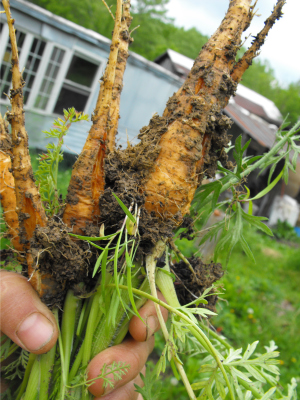
Overwintering carrots and parsnips
I
hope you'll bear with a second lunchtime
series of experimentation. If you're bored, say so and I'll try
to cut back
on future lunchtime series about experiments. Meanwhile, I've got
a book-related series on comfrey coming up, so stay tuned.
 Last summer when
the blight hit, I
was faced with several empty beds in
August. Even though it was a bit late for planting most fall
crops, I decided to seed carrots and parsnips, and the umbellifers did
grow beautiful ferny leaves to replace the blighted tomatoes.
However, when cold weather approached, I had to face the fact that my
crops hadn't been in the ground long enough to thicken their
roots, so I decided to cover them up with mulch and see what would
happen
in the spring.
Last summer when
the blight hit, I
was faced with several empty beds in
August. Even though it was a bit late for planting most fall
crops, I decided to seed carrots and parsnips, and the umbellifers did
grow beautiful ferny leaves to replace the blighted tomatoes.
However, when cold weather approached, I had to face the fact that my
crops hadn't been in the ground long enough to thicken their
roots, so I decided to cover them up with mulch and see what would
happen
in the spring.
I uncovered the carrots
and parsnips at the same time I uncovered the
strawberries, and the plants took off, once again turning their beds
into a jungle of leaves. I was so hopeful...until I pulled a few
up. The parsnip roots had gone woody inside while the carrots had
paled in color and turned bitter.
They were just barely edible enough to use in soup, but I would have
been
better off eating the small roots last fall when they were sweet and
crunchy.
I haven't gotten around
to pulling all of the parsnips out yet, and
they're starting to send up flower stalks --- the one positive result
of overwintering a biennial. I don't know if I have
enough plants to prevent inbreeding, but I'll at least let them bloom
since umbellifer
flowers are beloved by beneficial insects. And if I need
something to fill garden gaps in August, I'll stick to a late planting
of summer squash.
| This post is part of our Farm Experiments lunchtime series.
Read all of the entries: |
Want more in-depth information? Browse through our books.
Or explore more posts by date or by subject.
About us: Anna Hess and Mark Hamilton spent over a decade living self-sufficiently in the mountains of Virginia before moving north to start over from scratch in the foothills of Ohio. They've experimented with permaculture, no-till gardening, trailersteading, home-based microbusinesses and much more, writing about their adventures in both blogs and books.
Want to be notified when new comments are posted on this page? Click on the RSS button after you add a comment to subscribe to the comment feed, or simply check the box beside "email replies to me" while writing your comment.

Please don't stop. I love reading all of your posts over coffee in the morning. I just moved to a small farm(I guess I should say it's becoming a farm)and I very much enjoy the education and information the two of you give while we work to build our own homestead.
Thank you for this blog.
Aaron in Kansas
I love the experiments and updates. I have followed your lead on some things that worked out and stayed away from others because of some of you warnings.
I have carrots for the first time this year (all other years have been failures for different reasons). A couple of them are starting to go to seed. Is this normal? I thought they only did that during the second year.
Two of my best gardening lessons I have learned by experimentation: Onions truly do not like beans and will not grow with them and Corn and Kidney beans planted in alternating rows a foot apart and mulched with lawn clippings after they are about 3 inches tall makes for a truly work free garden with great production. (I'm still a row gardener, old habits)
I'm so glad the experiments have been helping. I was just thinking this morning, "Of course people like your experiments, Anna. The ones who hate them have already moved on to a fluffier blog!"
Your carrots shouldn't be going to seed --- that's strange! They're biennials, so they really should have to grow a full year before going to seed. The only thing I can think of is that maybe you started them so early that they built up enough reserves that they thought they could make it? When did you plant them?
I like your corn and bean alternation with lawn clippings --- it almost sounds like a do-nothing grain plot!